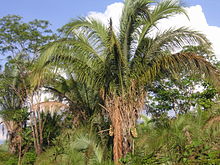Babassu oil
Babassu oil ( INCI : Orbignya oleifera ) is a yellowish-white vegetable fat that is obtained from the seeds of the South American babassu or cusi palm ( Attalea speciosa ) . Due to its melting point, it is semi-solid, sebum-like at room temperature ; in liquid form it is a clear, yellow oil. The odor of the native fat is nutty-coconut-like to tallowy, refined it is odorless.
use
Babassu oil is used as a food, but also in the manufacture of cleaning products such as soap and other skin care products. It can also be used as fuel. The properties of the oil are similar to coconut oil and it is also used to manufacture a similar range of products and is increasingly replacing them.
From a chemical point of view, babassu oil is a mixture of different triesters of glycerine and has a melting point that is relatively close to human body temperature. If babassu oil is applied to the skin, it can create a cooling effect through the heat transfer. Babassu oil has nourishing, protective and emollient properties and is supposed to counteract dehydration.
In February 2008, a blend of babassu and coconut oil was tested as an alternative fuel on a Virgin Atlantic Airways- sponsored Boeing 747 flight between London Heathrow and Amsterdam .
composition
The triglycerides are mainly composed of fatty acid residues of saturated fatty acids:
| fatty acid | proportion of |
|---|---|
| Caprylic acid | 3–12% |
| Capric acid | 3–7% |
| Lauric acid | 35-55.0% |
| Myristic acid | 9-27.0% |
| Palmitic acid | 5-11.0% |
| Oleic acid | 9-26.0% |
| Stearic acid | 2.5-5.5% |
| Linoleic acid | 1.5-3.5% |
The saponification number is 235–256, the iodine number is 10–20 and the melting point is 22–26 ° C, the density is 0.903–0.924 g · cm −3 (15 ° C). The cetane number is 38, the viscosity = 30.3 mm 2 / s (37.8 ° C), the calorific value is 37.5 MJ / kg. The oxidation stability is 7 to 17 hours at 130 ° C.
literature
- Sabine Krist: Lexicon of vegetable fats and oils. 2nd edition, Springer, 2013, ISBN 978-3-7091-1004-1 , pp. 107-112.
Individual evidence
- ^ Waldemar Ternes : Food Lexicon. 4th edition, Behr′s Verlag, 2005, ISBN 3-89947-165-2 , limited preview in the Google book search.
- ↑ Airline in first biofuel flight . In: BBC News . February 24, 2008. Retrieved October 26, 2009.
- ↑ David R. Lide (Ed.): CRC Handbook of Chemistry and Physics . 95th edition. (Internet version: 2015), CRC Press / Taylor and Francis, Boca Raton, FL, Biochemistry, pp. 7-12.
- ^ Geoff Talbot: Specialty Oils and Fats in Food and Nutrition. Woodhead, 2015, ISBN 978-1-78242-376-8 , pp. 116 f.
- ↑ Krist: p. 109.
- ^ BS Kamel, Y. Kakuda: Technological Advances in Improved and Alternative Sources of Lipids. Springer, 1994, ISBN 978-1-4613-5878-7 , p. 222.
- ^ Jan CJ Bart, N. Palmeri, Stefano Cavallaro: Biodiesel science and technology. Woodhead, 2010, ISBN 978-1-84569-591-0 , p. 116.
- ↑ K. Sivaramakrishnan, P. Ravikumar: Determination of cetane number of biodiesel and it's influence on physical properties. In: ARPN Journal of Engineering and Applied Sciences. Vol. 7, No. 2, 2012, online (PDF; 238 kB).
- ↑ Roseli Aparecida Ferrari, Marcia Paisano Soler: Obtention and characterization of coconut babassu derivatives. In: Sci. agric. (Piracicaba, Braz.). Vol. 72, No. 4, 2015, doi : 10.1590 / 0103-9016-2014-0278 .


